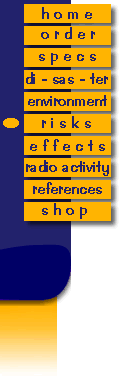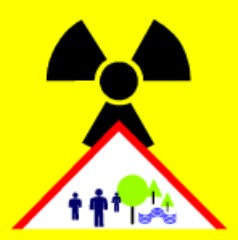

| RISKS ASSESSMENT | Order your RS-500 now! |

The nuclear terrorism risk is the highest risk as an estimated 50 suitcase nuclear weapons from Russia have disappeared after the fall of Communism. Newsweek mentionned that these nuclear weapons are known to be for sale for around 50 million dollars.
Another important risk comes from exposure to Radon, a gaseous breakdown product of radium, that can build up in enclosed spaces such as basements. YOU SHOULD TEST YOUR BASEMENT AND YOUR HOUSE FOR RADON. YOU SHOULD CHECK ANY HOUSE YOU CONSIDER BUYING OR MOVING IN. A potent alpha emitter, radon is believed to cause as many as 30,000 lung cancer deaths each year in the United States, alone.
Beside the high risk of exposure to Radon IN YOUR OWN HOUSE, we have identified 3 major nuclear risks :
- A terrorist attack; it could be:
- a conventional attack on a civil or military nuclear facility
- a nuclear attack on a city or a military base using stolen or custom made nuclear weapons
- A nuclear accident; it could be:
- in a civil nuclear powerplant or research center
- in a military facility, a Navy ship or a submarine
- A military conflict, with:
- depleted uranium ammunitions
- nuclear shelling of military targets on battlefield
- bombing of one or more cities or military targets
In case of a nuclear crisis, access to information might be limited by the government, as it was in Russia and in Europe during the Chernobyl crisis. This may increase your risk of exposure (just ask the Russians).
There are plenty of other smaller risks. According to the EC Commission, the risks are linked to the dangers arising from ionising radiation, resulting from practices using radiation or radioactive substances e.g. medical and industrial applications as well as the nuclear fuel cycle.
In addition to natural radiation sources, artificial radioactivity is present in the environment, in particular as a result of effluents from nuclear installations, fallout from weapons testing and from nuclear accidents.
Here is a list of the main risks, according to the EC Commission:
- exposure of the public,
- occupational exposure,
- medical exposure,
- natural radiation,
Maximum permissible exposure
Government standards for radiation protection are established by the National Council on Radiation Protection and Measurement (NCRP) and its international counterpart, the International Commission on Radiological Protection (ICRP). Both of these organizations offer recommendations for the maximum permissible dose (MPD) of radiation to which people should be exposed, and those recommendations are generally adopted by various government regulatory agencies (e.g., FAA, EPA, OSHA, NRC) as the maximum limits permitted by law. Current MPD limits are shown below:
|
|||||||||||||||||||||||||||
In making their maximum permissible dose recommendations, both NCRP and ICRP divide the population into two groups: members of the general public, and "radiation workers" who are exposed to radiation through their occupation. Government standards establish limits for occupational exposure that are 20 to 50 times greater than those established for the general public. The rationale is that "radiation workers" presumably accept the increased risk by informed consent as a trade-off in exchange for the benefits of employment.
Note that in addition to its annual MPD for occupationally exposed radiation workers, the NCRP recommends a cumulative lifetime limit (in mSv) equal to 10 times a worker's age. So, for instance, a pilot who retires at age 60 should not be exposed to more than 600 mSv over his entire flying career. Assuming that career lasts 30 years, average annual exposure should not exceed 20 mSv.
Note also that both organizations recommend drastically reduced limits for occupationally exposed workers during pregnancy.
![]()
Our new RS-500 radioactivity detector and meter measures nuclear radiation levels from the lowest background levels up to 999 mR/hr (10,000.00 ÁSv/h) (a level that can be reached only in a major nucelar accident or after the explosion of a nuclear weapon). This is 20 times more than ordinary radiation detection devices.
When set on, the alert will beep at a radioactivity level of 1mR/hr (standard nuclear industry radiation alert level).
The RS-500 radioactivity detector detects and measures Alpha, Beta, Gamma and X-Rays (A-B-G-X) radiation. Its digital display is easy to read and does not require switching between scales.
The RS-500 radioactivity detector is as portable as a small cell phone. It is designed for professional and personal use.
Because nuclear emergencies (nucelar terrorist attack, nuclear weapon, radioactive contamination, nukelar accident, etc...) may produce high to very high levels of radiation, the RS-500 high range makes it the best choice for Police departments, security and military personnel, as well as for individual and family safety. Other devices generally saturate before radiation levels become really dangerous and can measure only "safe" radiation levels. They become useless when they are most needed!
We recommend you keep your radiations detector at all time inside the vehicle you would use in case of a radioactivity emergency. This may save precious time should a major radioactive threat occur .